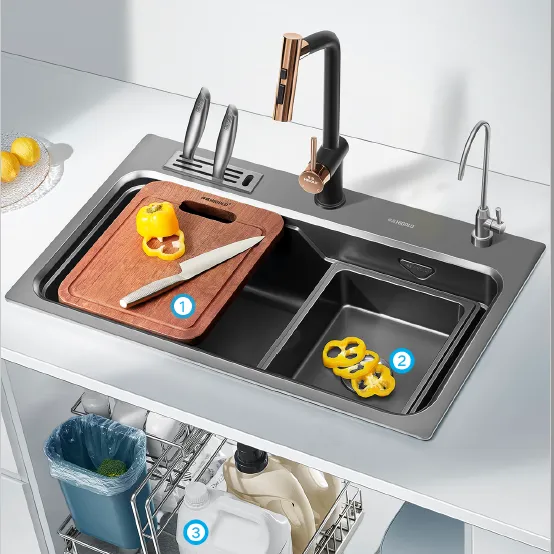In modern kitchen renovations, the combination of sink and faucet not only affects functionality but also directly impacts the overall aesthetic. Many consumers often ask themselves: Can I install a black faucet with a stainless steel sink?
This article will address this question in detail from four perspectives: design aesthetics, material matching, installation techniques, and ongoing maintenance. It will also comprehensively explain the feasibility and advantages of combining a black kitchen faucet with a stainless steel sink.

Black Kitchen Faucet and Stainless Steel Sink: Aesthetic Combination
1. Color Contrast and Visual Effect
A black kitchen faucet is a striking accent in a kitchen. Its deep, calming color creates a striking contrast in bright or cool kitchen spaces. Stainless steel sinks, with their inherent silver-gray sheen, offer a modern and industrial feel. When paired with a stainless steel sink, a black kitchen faucet creates a strong visual contrast, adding a layered and modern feel to the overall kitchen. This color combination not only avoids conflict but actually enhances the sink's gloss and the faucet's design.
2. Color Harmony in Modern Kitchen Design Trends
In modern kitchen design, black is often used to emphasize a refined and luxurious feel. A black kitchen faucet creates a visual focal point alongside a stainless steel sink, adding a striking design element to a minimalist kitchen. Even in open kitchens, the combination of a black faucet and a stainless steel sink creates a harmonious color palette with the cabinets and countertops, enhancing the overall aesthetics of the kitchen space.
Black Kitchen Faucets and Stainless Steel Sinks: Durability Analysis
1. Material Characteristics of Black Kitchen Faucets
Currently, black kitchen faucets on the market primarily utilize copper, stainless steel, or aluminum alloy as their base materials, achieving their black appearance through high-temperature lacquer, electrophoretic coating, or PVD coating. These surface treatments not only ensure the black kitchen faucet's aesthetic appeal but also enhance its corrosion, oxidation, and wear resistance. In high-humidity environments like kitchens, high-quality black kitchen faucets with a surface treatment effectively resist water stains, oil stains, and the abrasion associated with daily cleaning.
2. Material Properties of Stainless Steel Sinks
Stainless steel sinks have long been a popular choice for kitchen sinks due to their high strength, corrosion resistance, high temperature resistance, and ease of cleaning. 304 stainless steel offers excellent rust resistance, making it suitable for long-term kitchen use. Furthermore, the neutral silver-gray appearance of stainless steel sinks pairs well with a variety of faucet colors, including black. This combination is perfectly feasible from both a material and color perspective.
3. Material Compatibility and Lifespan
The high-hardness coating of black kitchen faucets perfectly matches the wear resistance of stainless steel sinks, preventing significant wear and tear from daily use. Furthermore, both materials are corrosion-resistant and exhibit no noticeable aging or discoloration even with prolonged exposure to water and detergents. Therefore, combining a black kitchen faucet with a stainless steel sink is safe and reliable, considering both material compatibility and longevity.

Black Kitchen Faucet and Stainless Steel Sink: How to Install?
1. Pre-Installation Dimension Matching
Before installing a black kitchen faucet and a stainless steel sink, first confirm that the sink and faucet hole diameters and mounting heights match. Black kitchen faucets typically have single-hole and multi-hole mounting options, while stainless steel sinks may have single-hole or three-hole layouts. Ensuring that the faucet base diameter fits the sink's pre-installed holes is the first step to a smooth installation.
2. Plumbing and Connector Compatibility
Black kitchen faucet connectors typically use standard G1/2 threads, compatible with most stainless steel sinks and sewer systems. During installation, pay attention to the length and bend angle of the pipes to avoid stretching or bending the pipes, which could lead to loose connections and impair water flow or create leaks.
3. Installation Order and Fixing Method
When installing a black kitchen faucet and a stainless steel sink, it is recommended to install the sink first, followed by the faucet, to ensure a more secure fit and prevent uneven force on the faucet during installation. When installing the faucet, use the included washers and nuts to secure it, and check that the connectors are properly sealed. For black kitchen faucets with a swivel function, ensure that the swivel range is not restricted by the sink rim.
4. Sealing and Leak-Proofing
The connection between the stainless steel sink and the black kitchen faucet requires waterproof sealant or a rubber gasket to prevent water leakage after installation. High-end black kitchen faucets, in particular, may have multiple valve cores and seals. Proper installation can prevent dripping or leaking during daily use and improve user comfort.
Black Kitchen Faucets and Stainless Steel Sinks: Daily Cleaning and Maintenance
1. Cleaning Black Kitchen Faucets
Black kitchen faucets are typically treated with an anti-fingerprint finish, but water or oil stains may still appear after long-term use. When cleaning, use a soft cloth and a neutral detergent. Avoid strong acids or alkalines and steel wool to prevent scratches on the surface. Regular cleaning not only maintains the black gloss but also extends the life of the faucet.
2. Maintaining Stainless Steel Sinks
Stainless steel sinks should be kept away from acidic or alkaline residues to prevent surface corrosion. For cleaning, it's recommended to use a neutral detergent or a stainless steel cleaner, wiping with a soft cloth or sponge. Since black kitchen faucets and stainless steel sinks have different surface materials, the cleaning agent should be chosen to ensure both are protected and maintain the stainless steel's shine.
3. Avoid Chemical Reactions
Although both black kitchen faucets and stainless steel sinks are corrosion-resistant, prolonged exposure to chlorine- or acidic-containing detergents may slightly affect the coating and stainless steel surface. Therefore, for routine maintenance, choose a mild detergent and rinse thoroughly with clean water after cleaning to keep the surface dry.

Black Kitchen Faucets and Stainless Steel Sinks: What are the Advantages of Combining Them?
1. Functionality
Black kitchen faucets often feature high elbows, pull-out spouts, and 360-degree swivels. Combined with the spacious bowl of a stainless steel sink, they greatly enhance kitchen convenience. Whether washing large pots and pans or simply cleaning the sink, a black kitchen faucet and stainless steel sink combination provides efficient operation.
2. Aesthetic and Stylistic Unity
A black kitchen faucet creates a unique visual contrast with a stainless steel sink, while also offering greater flexibility in color coordination with countertops and cabinetry. Whether your kitchen is designed for modern minimalism, industrial chic, or high-end luxury, a black kitchen faucet and stainless steel sink combination enhances the overall visual quality.
3. Durability and Value
Because both black kitchen faucets and stainless steel sinks are constructed from durable materials and advanced craftsmanship, they maintain a long lifespan even with heavy use. This combination not only ensures the stability and durability of the kitchen equipment, but also offers excellent value in the market, making it a preferred option for home kitchen renovations.

Can a black faucet be installed with a stainless steel sink?
Of course, installing a black kitchen faucet with a stainless steel sink is not only completely feasible, but also offers distinct advantages in terms of aesthetics, material quality, installation, and daily use. A black kitchen faucet adds an elegant, modern look to the kitchen space, creating a beautiful contrast with the silver-gray sheen of the stainless steel sink. The two materials are highly compatible and have a long lifespan. Installation is proven and safe, and daily cleaning and maintenance are also very convenient.
How does Higold ensure strong partnerships with long-term clients?
Higold builds trust by offering consistent quality, reliable supply, competitive pricing, and transparent communication. Long-term clients benefit from loyalty discounts, priority access to new designs, and flexible payment terms. By treating buyers as partners rather than just customers, Higold creates sustainable business relationships that support growth on both sides.


